Definition
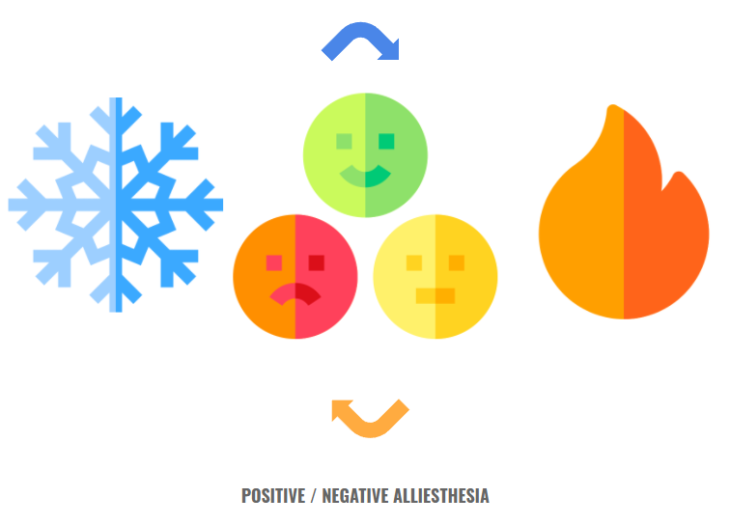
The phenomenon of alliesthesia is used to differentiate between perceived pleasure and neutrality. Alliesthesia depends on the subject’s physical and psychological state. The body has a natural set-point and any change to the body can produce a positive or negative perception. If an external stimulus acts on the body by restoring its set-point, then it will be perceived as pleasure or positive alliesthesia. If an external stimulus invokes a change that drives the body further away from its set-point, then it will be perceived as displeasure, or negative alliesthesia. Naturally, a body seeks pleasant stimuli and avoids unpleasant ones.
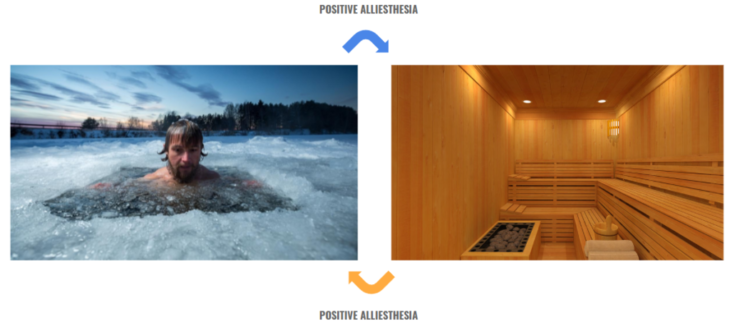
image credits from left to right:
Dudarev Mikhail/Shutterstock
Creative Commons: Creative Commons (CC) license
Typically, the body perceives neutrality as ‘comfortable’. ‘Very comfortable’ is only perceived by the body when it goes through a transition from an uncomfortable state to its natural set-point. One example of allesthesia is the perceived difference between going from an ice bath to a hot sauna, which would produce positive alliesthesia. No thermal change to the body would be considered neutral and entering a hot sauna when the body is already at its natural set-point would be considered negative alliesthesia. This is an example of extremes, however on a more moderate scale the concept can relate to Heating Ventilation and Air Conditioning (HVAC) in buildings. Transient states can have pleasant effects on the body, yet current indoor climate standards are based around a model of static thermal environments. Any deviation from standard indoor air temperature is considered negative. If a system produces a draft that can be perceived by the occupants, it is an indication of poor HVAC design. The concept of alliesthesia provides an opportunity to rethink the current heating and cooling strategies in buildings, especially in the context of the climate crisis.
Richard de Dear (2011) Revisiting an old hypothesis of human thermal perception: alliesthesia, Building Research & Information, 39:2, 108-117, DOI: 10.1080/09613218.2011.552269
Thermal Alliesthesia
Allesthesia was first coined by Michael Cabanac in 1968. The fundamentals of thermal alliesthesia is based on any peripheral thermal stimulus that offsets or counters thermoregulatory load-error will be pleasantly perceived. To prove his ideas, Cabanac performed a study where he placed water infused gloves on peoples’ hands whose temperature they were able to control themselves, while sitting with the rest of their body in a tub of water whose temperature was controlled by the experimenters. He found that subjects would find it pleasurable to increase the temperature in their gloves whenever their core body temperatures were being lowered, but preferred to decrease their glove temperature if body temperature was increased. This was even true when the temperature of the body was much hotter or colder than typical homeostatic temperature, indicating that pleasure is a relative sensation as opposed to an absolute one.
H. Hensel also performed some interesting experiments surrounding thermal comfort, specifically cutaneous thermoreceptors. He found a few key things worth pointing out.
- “Cold receptors are generally located closer to the skin than warm receptors”
- Receptors have optimal temperatures for firing, 41-47C for warm receptors and 17-36 C for cold receptors.
- There are static receptors that fire when exposed to continuous stimulation and dynamic ones that experience large spikes in reactivity when exposed to sudden changes in temperature, but decay in responsiveness as a new steady state of temperature has been reached.
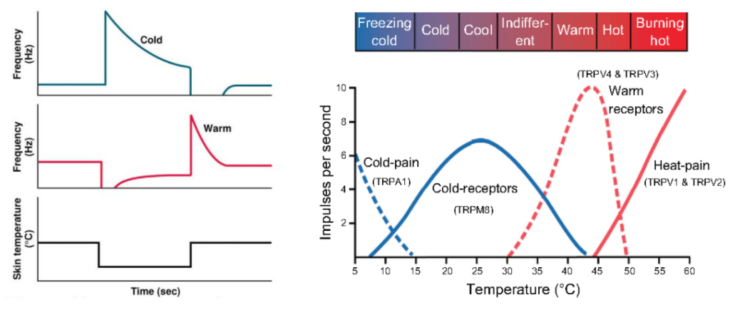
image credits from left to right:
https://www.d.umn.edu/~jfitzake/Lectures/DMED/Somatosensation/Somatosensation/TempPerceptionExp.html
https://www.researchgate.net/publication/281517869_Recent_advances_in_thermoregulation
These three points mean that we will often feel much greater dissatisfaction with cold changes in temperature compared to warm ones, have difficulty differentiating between hot and extremely hot temperatures and cold and extremely cold temperatures, and lastly, we can derive pleasure from a change in temperature due to the presence of static and dynamic receptors.
Adding onto Hensel’s research, De Dear completed an interesting study on thermal perception where he left 12 college-aged students in a room of one temperature for 90 minutes and then abruptly put them in another room of another temperature for another 90 minutes. He asked them to rate their whole body temperature based on the PMV scale from -3 to 3, and found that immediate comfort indexes swung twice as much when moved to a colder room than to a hotter room. He was able to simulate these results numerically by modelling cold thermoreceptors at a distance of 0.2 mm away from the skin’s surface and warm ones 0.5 mm away, confirming Hensel’s original research.
Summary of research/experiments done in this field
- What are the signals driving sensation and are they different to those driving comfort/pleasantness?
- mean and local skin temperatures
- skin temperature comfort set-point
- time derivative of skin temperature
- core temperature
- time derivative of core temperature
- The neural drives for temperature regulation generated in the anterior hypothalamus
- The temperature regulatory effector actions themselves, (shivering and sweating ).
Richard de Dear (2011) Revisiting an old hypothesis of human thermal perception: alliesthesia, Building Research & Information, 39:2, 108-117, DOI: 10.1080/09613218.2011.552269
ASHRAE and EN15251 have reflected awareness, basically that thermal alliesthesia has been proposed as a conceptual framework. What this means is to standardize the concept from non-steady-state, neutrality and steady-state environments.
Water immersion protocol as Cabanac to evaluate the hedonic characteristics of the relationship between the pleasant and unpleasant. In this precedent, pleasantness was clearly dependent upon the disposition on thermal stimulation.
https://www.tandfonline.com/doi/abs/10.1080/09613218.2015.989662
Other Types of Alliesthesia
Alliesthesia was initially observed in relation to skin temperature and sweet tastes only. It was later observed in all sensory cognitions. Below are the types of allesthesia related to sensation:
- thermal alliesthesia: alliesthesia of the perception of thermal comfort
- olfactory alliesthesia: alliesthesia of olfaction (sense of smell)
- gustatory alliesthesia: alliesthesia of taste (sweet, salty, bitter, acid, umami and calcium)
- olfacto-gustatory alliesthesia or alimentary alliesthesia: alliesthesia of tastes/flavors pertaining to food intake
- visual/optic alliesthesia: alliesthesia of vision
- auditory alliesthesia: alliesthesia of the sense of hearing
https://en.wikipedia.org/wiki/Alliesthesia

Experimental evidence shows that alliesthesia has also been demonstrated in non-sensory experiences. Below is a list of the non-sensory experiences that have been shown to generate allesthesia:
- Drugs and hormones
- Pain
- Muscular exercise
- Mental processes
- Curiosity
- Money
- Play
- Gambling
- Aggressiveness
- Politics
- Learning and Memory
- Animals

This evidence suggests that alliesthesia can play a role in ethical decision making processes, since human subjects tend to maximize their sense of pleasure and avoid displeasure. As designers reevaluate the current HVAC standards in buildings, they might consider the ethical implications of sustainable versus unsustainable building design and the effect it might have on occupant comfort.
Michel Cabanac, Laurent Brondel, Arnaud Cabanac. Alliesthesia. Up-date of the Word and Concept. 2020 – 8(4). AJBSR. MS.ID.001293. DOI: DOI: 10.34297/AJBSR.2020.08.001293.
Examples in the Built Environment
Example 1:
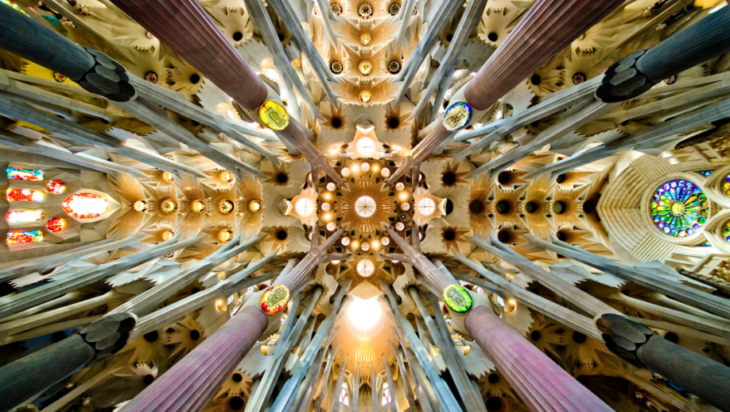
image credits:
Sagrada Familia as an example reminds us of culture, nature and the endless possibilities through geometry. Every well intended shape, colour and shade could provide an experience of calm and connection between nature and nurture.
Interpretation based on windows/glass:
Portal of Nativity:
Colors:
- yellow
- green
- blue
Meaning: the birth of Christ, poverty and light.
Facade of the Passion:
Colors:
- yellow
- orange
- red
Meaning: Water, light and resurrection.
The cluster of every feature mentioned before brings us a brief reminder of a solemn connection between the sacred and nature.
Example 2:
As the example above, windows have a lot of relationship between emotions and experience.
The following example is about how a window could provide a set point of cognitive performance inside of buildings. How to measure subjective thermal perceptions with a survey.
Measuring their thermal sensation using the ASHRAE seven-point continuous scale from cold to hot. Acceptability scales also used a seve-point continuous scale from “very uncomfortable” or very “unacceptable” to “very comfortable” or “very acceptable”.
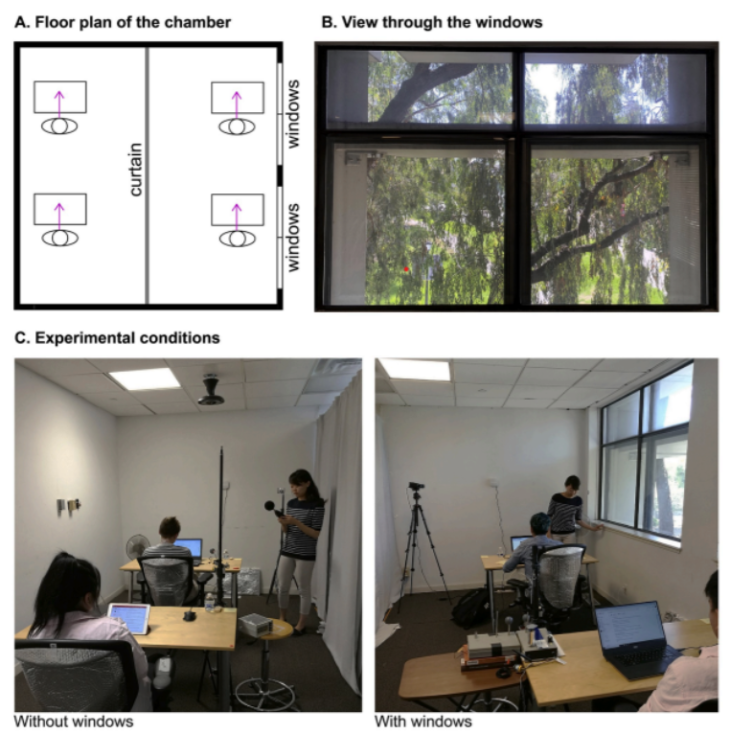
image credits:
https://www.sciencedirect.com/science/article/abs/pii/S0360132320301372
Emotions were assessed using a circumplex model. It describes eight emotions with positive and negative values.
Low-arousal:
- quiet
High-arousal:
- Surprised
Negative:
- Dull
- Fearful
- Sad
Positive:
- Happy
- Calm
- Enthusiastic
At the same time during the assessment they used a web-based platform for the assessment of cognitive performance.
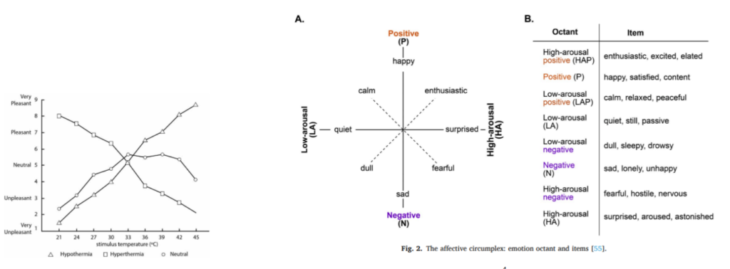
image credits:
https://www.sciencedirect.com/science/article/abs/pii/S0360132320301372
Session procedure:
4 participants were randomly assigned, 2 participants where at the space with windows
And the other two were in a space without windows.
In the workstation they used temperature skin sensors at four body locations.
They also provide them with an initial survey with questions about their thermal perceptions of the space, emotion , perceived stress level.
Based on the attention theory, engaging with nature effortlessly allows people to recover the ability of direct-attention.
Something interesting to recall in this experiment was the possibility of the bias generated. During this experiment the data of two participants were dropped because they violated the rules. Basically something like drinking iced water in one of the sessions could affect the final results of the research.
“The impact of a view from a window on thermal comfort, emotion and cognitive performance. Won Hee Ko a,* Stefano Schiavon, Hui Zhang, Lindsay T. Graham, Gail Brager, Iris Mauss & Yu-Wen Lin
Example 3
This final example is based on how we sense thermal domains between user interpretation, colors (warm/cold) and field of vision. How we could measure their thermal condition/state by experience.
Data extraction from thermal analysis provides an advantage to digitize environments and understand behaviors by patterns related to indoor/outdoor temperature, materials and activities in spaces.
By digitizing these patterns, it could bring an opportunity to broadcast the understanding of cognitive performance by thermal conditions and interpolation between thermal machine vision models and facial recognition models.
Beside decision making these techniques have been used to monitor users inside buildings to guarantee their safety.
For example, Descriptive Analytics of Seniors’ Daily Activities for long term health monitoring. “Fei Fei Li research”.
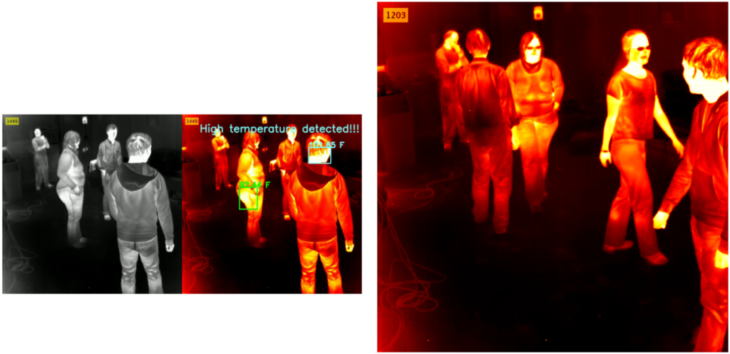
image credits from left to right:
https://medium.com/@feat7/a-tutorial-on-camera-based-thermal-screening-using-computer-vision-d8b3304c08e3
http://proceedings.mlr.press/v85/luo18a/luo18a.pdf
As example 2 were classify emotions and somehow had been labelled manually, facial recognition models could be trained with the same principals. Machine vision systems are growing to be faster and efficient to analyse images which could bring another option to be on time and address the convergence between thermal comfort, cognitive performance and building evaluation.
image credits from left to right:
https://www.mentalfloss.com/article/74571/infrared-video-shows-how-hummingbirds-shed-heat-through-their-eyes-and-feet
https://www.thoughtworks.com/insights/articles/recognizing-human-facial-expressions-machine-learning
Code Implementation: ASHRAE 55 – Adaptive Comfort (US)
One of the main comfort parameters used in building design today is the Predicted Mean Vote (PMV) index. It was developed in 1982 by a man named P.O. Fanger to predict the comfort of a group based on a 7 point scale with -3 being too cold, 0 being neutral, and +3 being too hot. The PMV index is derived empirically from the equation below, and takes into account a person’s metabolic rate, and clothing type, along with dry bulb temperature, mean radiant temperature, humidity and indoor wind speed.
PMV = (0.303 e-0.036M + 0.028) L
Where PMV = Predicted Mean Vote Index
M = metabolic rate,
L = thermal load – defined as the difference between the internal heat production and the heat loss to the actual environment – for a person at comfort skin temperature and evaporative heat loss by sweating at the actual activity level
Derived from the PMV, Fanger also developed the Predicted Percentage Dissatisfied (PPD) index to predict the percent of people dissatisfied in a given room.

image credits:
https://www.engineeringtoolbox.com/predicted-mean-vote-index-PMV-d_1631.html
ASHRAE-55 requires that PPD values be below at least 20% for indoor thermal conditions. Although this method has been the accepted code standard for some time, studies have shown that its accuracy in predicting thermal comfort levels is only around 34%. Even though the PMV index does take into account many quantitative factors, there are also many things that it also ignores. For instance, it doesn’t take into account:
- Biological Differences: older people have slower metabolisms and thus are more partial to warmer temperatures
- Gender Differences: studies have shown that while women are more sensitive to colder temperatures than men, while men are more sensitive to humidity level
- Regional Differences: people in different regions have adapted to have different comfort levels.
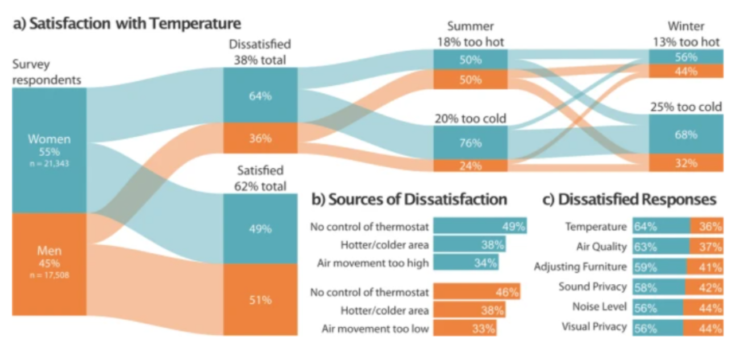
Karjalainen, Sami (2007). “Biological sex differences in thermal comfort and use of thermostats in everyday thermal environments”. Building and Environment. 42 (4): 1594–1603.
Lan, Li; Lian, Zhiwei; Liu, Weiwei; Liu, Yuanmou (2007). “Investigation of biological sex difference in thermal comfort for Chinese people”. European Journal of Applied Physiology. 102(4): 471–80.
One interesting initiative the Japanese government has tried, to increase comfort and reduce energy usage, is the encouragement of casual dress in the office as opposed to the more traditional dress in business suits. They found that wearing cool, more casual clothes made people made people content with a 2 degree temperature increase in offices during the summer time, resulting in an estimated reduction in carbon dioxide emissions of almost 1.7 million metric tons. Comfort and energy saving can be achieved with very simple solutions.

image credits:
https://mainichi.jp/english/articles/20190504/p2a/00m/0na/024000c
In his paper, Revisiting and Old Hypothesis of Human Thermal Perception: Alliesthesia, De Dear’s cites another interesting criticism of the PMV index, saying that it is founded founded on the idea of a lack of sensation as opposed to questioning if the participant likes or dislikes the feeling of neutrality.
More recently, the Center for the Built Environment (CBE) has made efforts to improve code standards surrounding thermal comfort. In 2004 the CBE performed studies to determine the relationship between the outdoor air temperature, indoor wind speed, and desired indoor air temperature. The study included 21,000 participants in 160 buildings located in various countries and four different climate zones. They found that in mechanically sealed buildings, occupants prefer a relatively stable indoor temperature regardless of change in the outdoor temperature. However, in buildings that rely solely on natural ventilation, occupants actually prefer to experience a range of indoor temperatures correlated positively with the outdoor temperature. In other words, on hotter days, occupants don’t mind being in a building that would typically be classified as too hot according to previous ASHRAE comfort standards as long as it is relatively cooler inside than outside and vice versa in regards to cold temperatures. These studies have been implemented into US building code, giving designers of naturally ventilated buildings more freedom in their design and more realistic comfort parameters to work with.
CBE has developed an online thermal comfort tool to help designers find thermal comfort standards for their building with either the PMV or Adaptive method.
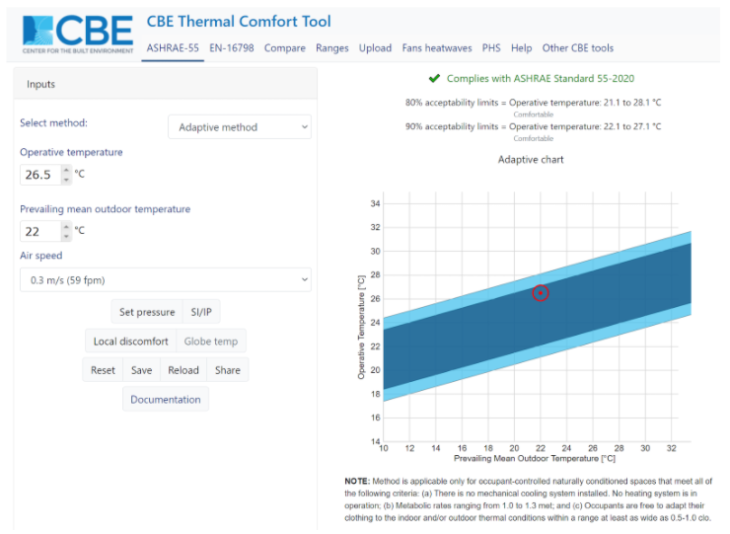
images credits:
https://comfort.cbe.berkeley.edu/
Conclusions
Interoperability between computational tools and mixed reality could improve the feedback loop for occupancy evaluation in buildings. Decoding thermal conditions to use them as input could provide a better quality of data sets to inform building environments.
Thermal comfort is a very complex issue to capture, especially in building code. There are numerous different metrics which try to capture it, including the PMV, PPD, UTCI, and many others. However, most of these indexes, besides the Adaptive Comfort Model, fail to take into account the effects of alliesthesia or the psychological aspects surrounding comfort. By gaining a better understanding of what comfort is and how we all perceive it differently, we can better heat and cool our buildings. Not only for our own comfort, but also as a means to prevent unnecessary under or over cooling of buildings to conserve energy.
The phenomenon of alliesthesia in the realm of architecture and design has the potential to optimize experiences through transitory sensorial states. Alliesthesia also has applications in computational design. The hedonic quality of an environment can be generated by varying certain desired transient parameters. Once a particular transient environmental attribute is identified, it can be programmed and optimized for the occupants. These parameters can be related to olfactory alliesthesia, visual/optic alliesthesia, auditory alliesthesia and thermal alliesthesia. The latter has the potential to optimize energy efficiency in buildings. Specifically, personalized thermal comfort presents a solution for air-conditioning being a major contributor to climate change.
